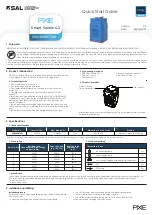
5.
Repeat Steps 1 to 4 to configure all remaining dot1p priorities in an ETS priority group.
6.
Specify the dot1p priority-to-priority group mapping for each priority.
priority-pgid
dot1p0_group_num dot1p1_group_num ...dot1p7_group_num
Priority group range is from 0 to 7. All priorities that map to the same queue must be in the same
priority group.
Leave a space between each priority group number. For example: priority-pgid 0 0 0 1 2 4 4 4 in
which priority group 0 maps to dot1p priorities 0, 1, and 2; priority group 1 maps to dot1p priority 3;
priority group 2 maps to dot1p priority 4; priority group 4 maps to dot1p priorities 5, 6, and 7.
Dell Networking OS Behavior:
A priority group consists of 802.1p priority values that are grouped for
similar bandwidth allocation and scheduling, and that share latency and loss requirements. All 802.1p
priorities mapped to the same queue must be in the same priority group.
Configure all 802.1p priorities in priority groups associated with an ETS output policy. You can assign
each dot1p priority to only one priority group.
By default, all 802.1p priorities are grouped in priority group 0 and 100% of the port bandwidth is assigned
to priority group 0. The complete bandwidth is equally assigned to each priority class so that each class
has 12 to 13%.
The maximum number of priority groups supported in ETS output policies on an interface is equal to the
number of data queues (4) on the port. The 802.1p priorities in a priority group can map to multiple
queues.
If you configure more than one priority queue as strict priority or more than one priority group as strict
priority, the higher numbered priority queue is given preference when scheduling data traffic.
ETS Operation with DCBx
The following section describes DCBx negotiation with peer ETS devices.
In DCBx negotiation with peer ETS devices, ETS configuration is handled as follows:
• ETS TLVs are supported in DCBx versions CIN, CEE, and IEEE2.5.
• The DCBx port-role configurations determine the ETS operational parameters (refer to
).
• ETS configurations received from TLVs from a peer are validated.
• If there is a hardware limitation or TLV error:
– DCBx operation on an ETS port goes down.
– New ETS configurations are ignored and existing ETS configurations are reset to the default ETS
settings.
• ETS operates with legacy DCBx versions as follows:
– In the CEE version, the priority group/traffic class group (TCG) ID 15 represents a non-ETS priority
group. Any priority group configured with a scheduler type is treated as a strict-priority group and
is given the priority-group (TCG) ID 15.
– The CIN version supports two types of strict-priority scheduling:
* Group strict priority: Use this to increase its bandwidth usage to the bandwidth total of the
priority group and allow a single priority flow in a priority group. A single flow in a group can
use all the bandwidth allocated to the group.
Data Center Bridging (DCB)
301
Summary of Contents for S4820T
Page 1: ...Dell Configuration Guide for the S4820T System 9 8 0 0 ...
Page 282: ...Dell 282 Control Plane Policing CoPP ...
Page 622: ...Figure 81 Configuring Interfaces for MSDP 622 Multicast Source Discovery Protocol MSDP ...
Page 623: ...Figure 82 Configuring OSPF and BGP for MSDP Multicast Source Discovery Protocol MSDP 623 ...
Page 629: ...Figure 86 MSDP Default Peer Scenario 2 Multicast Source Discovery Protocol MSDP 629 ...
Page 630: ...Figure 87 MSDP Default Peer Scenario 3 630 Multicast Source Discovery Protocol MSDP ...
Page 751: ...10 11 5 2 00 00 05 00 02 04 Member Ports Te 1 2 1 PIM Source Specific Mode PIM SSM 751 ...
Page 905: ...Figure 112 Single and Double Tag First byte TPID Match Service Provider Bridging 905 ...
Page 979: ...6 Member not present 7 Member not present Stacking 979 ...
Page 981: ...storm control Storm Control 981 ...
Page 1103: ...Figure 134 Setup OSPF and Static Routes Virtual Routing and Forwarding VRF 1103 ...
















































